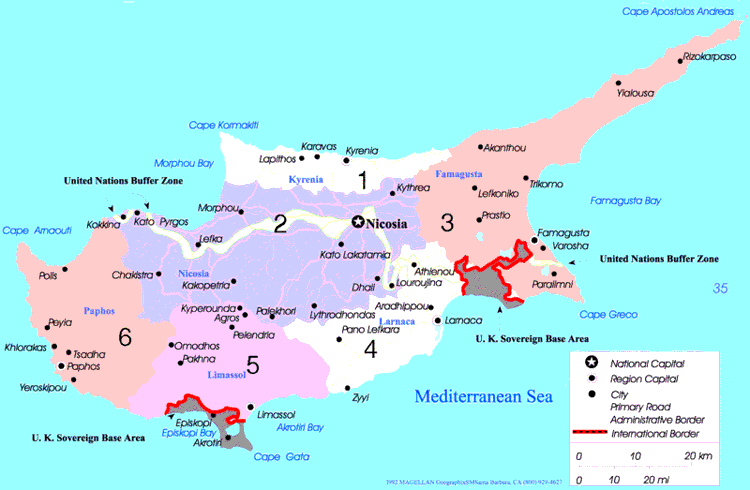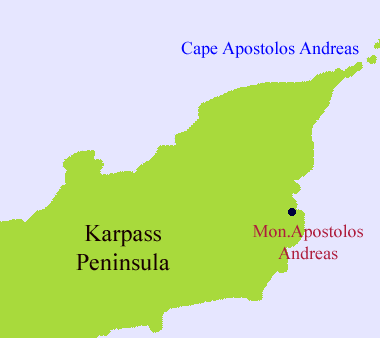|
|
  Map of tip of Karpass Peninsula (Cyprus) showing location of the Apostolos Andreas Monastery Apostolos Andreas Monastery (35°39′34″ N 34°34′17″ E) is situated just south of Cape Apostolos Andreas (Cape of Saint Andrew), which is the north-eastern most point of the island of Cyprus (within the juristiction of the Turkish Republic of Northern Cyprus). The monastery is dedicated to Saint Andrew (Apostle Andreas). According to the holy books, he was the first person to be called for induction to priesthood by Jesus Christ, His title was O Protoklitos meaning:‘the one first called. The monastery is one of the pilgrimage centres of the Orthrodox Church of Cyprus. It was once known as 'the Lourdes of Cyprus', served not by an organized community of monks but by a changing group of volunteer priests and laymen. An enormous modern plaza of pilgrims' lodgings frames the slightly older monastery buildings wrapped around the central church. Below, the modern church steps lead down to a square, vaulted chapel, three baptismal basins fed by a sacred spring and an old wharf. It was on this site that it was said St. Andrew briefly landed in Cyprus on his final missionary journey back to his Palestinian homeland. His footfall revealed a spring whose waters miraculously healed the blind captain of his ship. On the bust in the courtyard of the monastery is an inscription stating that the monastery was built by Ionnis Oicoromus. A fortified monastery stood here in the 12th century, from which Isaac Comnenus negotiated his surrender to Richard the Lionheart, though the chapel built in the 15th century is the oldest surviving building.
Story of Apostolos Andreas (St. Andrew) According to the Holy books, St. Andrew was the brother of St. Peter, who served John the Baptist and was the first of the apostles to be called to ministry by Jesus. His missionary areas had covered much of the medieval borderland of Byzantium, such as Macedonia and the Black Sea coast, with miraculous incidents set in Nicea, Thessalonica and Ethiopia. Images of his martyrdom depict him as a white-bearded old man of 80, tied to an olive tree cross that stood by the sea shore at Patras in the Peloponnese. Even during his crucifixion, he continued to preach for two days before he finally died. He is the patron saint of Greece, Russia, and Scotland, a 'protector of travellers and commander of winds'. His feast day is celebrated annually on 15 August and 30 November. Worshippers The monastery only became a popular sanctuary with the miracle of Maria Georgiou in 1895. It is said that seventeen years after the disappearance of her son, she received a dream in answer to her unceasing petitions to St. Andrew, which instructed her to go from her native Sicily to the neglected monastery of Apostolos Andreas. On the voyage to Cyprus, she explained her journey to fellow passengers and particularly excited the attention of a young man. He asked Maria how she would identify her lost son, so she told him of the peculiar pair of birthmarks that he bore on his shoulder and chest. The young man then threw off his woolen cloak to expose the same marks and fell on his knees before his mother. Within months of this event, the shrine received a stream of pilgrims which increased into a flood as the saint proved his power over a random tithe of supplicants, Greeks as well as Turks, sophisticated Athenians as well as local peasants. Both the Turkish and Greek Cypriot communities consider the monastery a holy place. As such it is visited by many people for votive prayers. The contents of the monastery are also noteworthy. The United Nations declared the monastery a World Heritage site, but recently, there have been concerns about the natural deterioration of the buildings at the site. Retrieved from "http://en.wikipedia.org"
 |
|
|||||||||||||||||